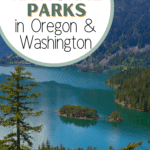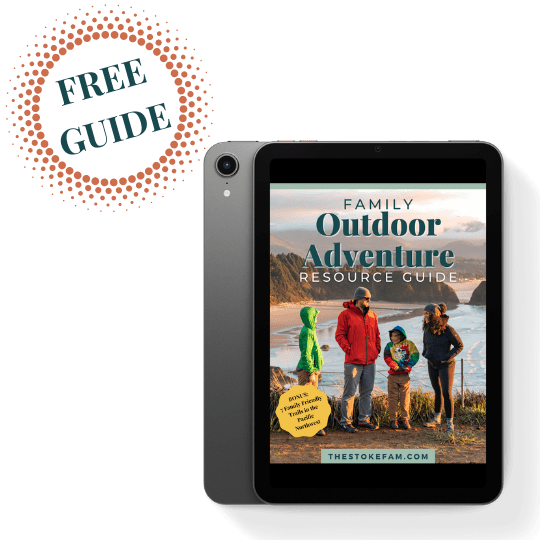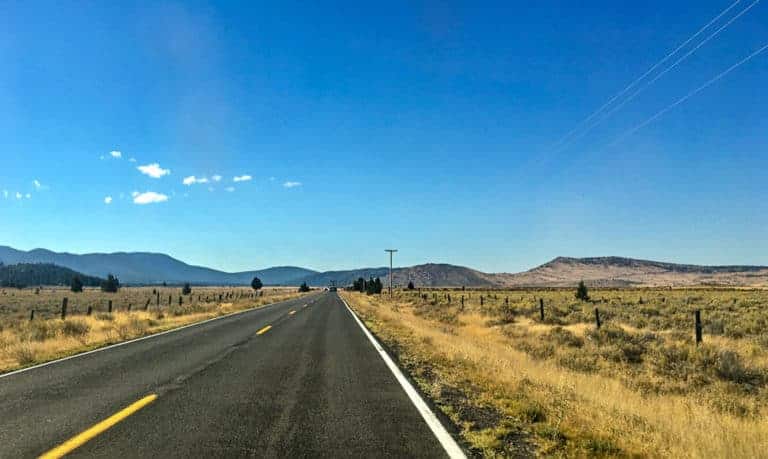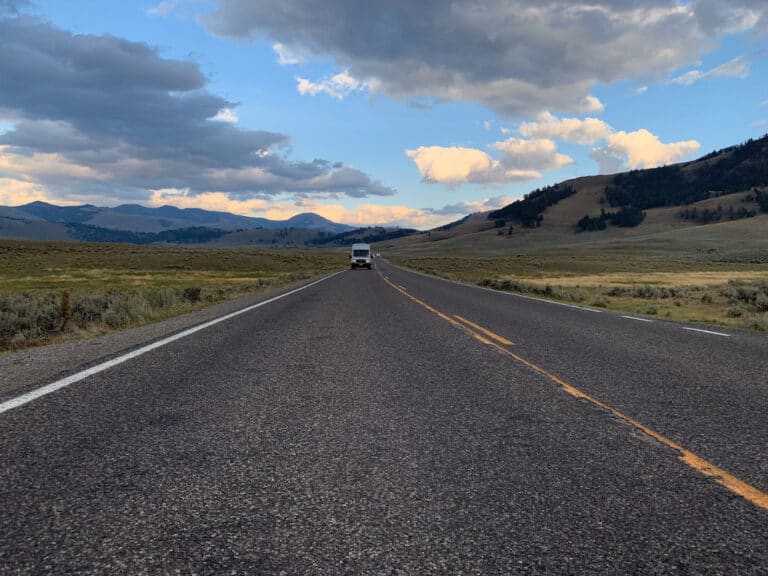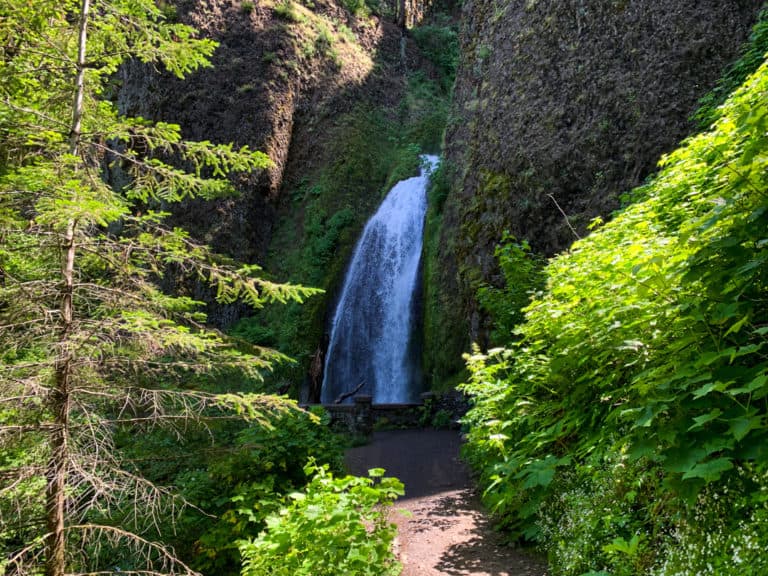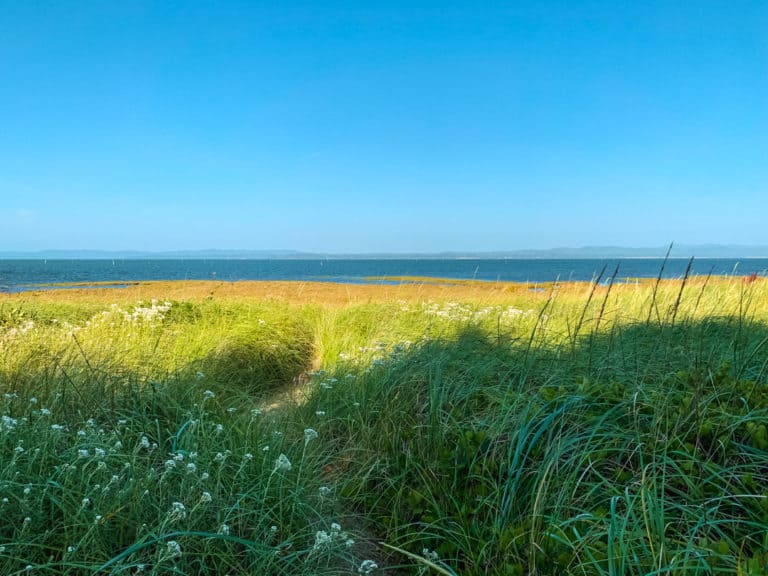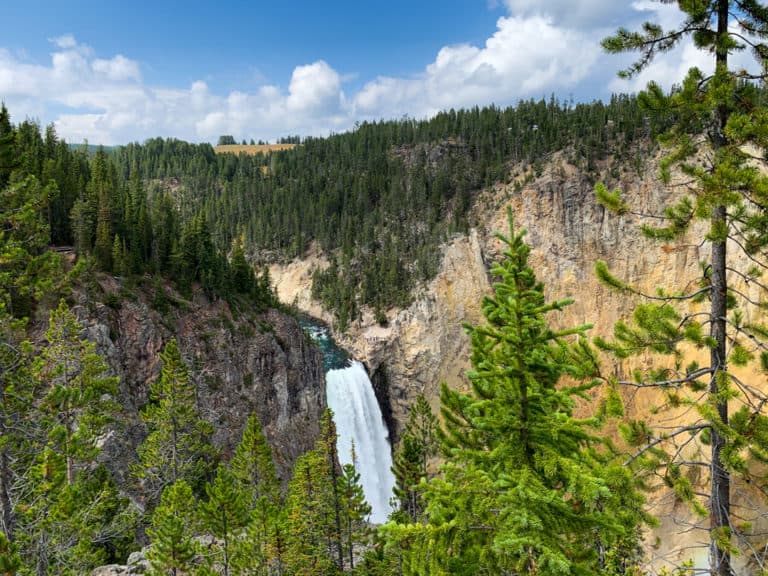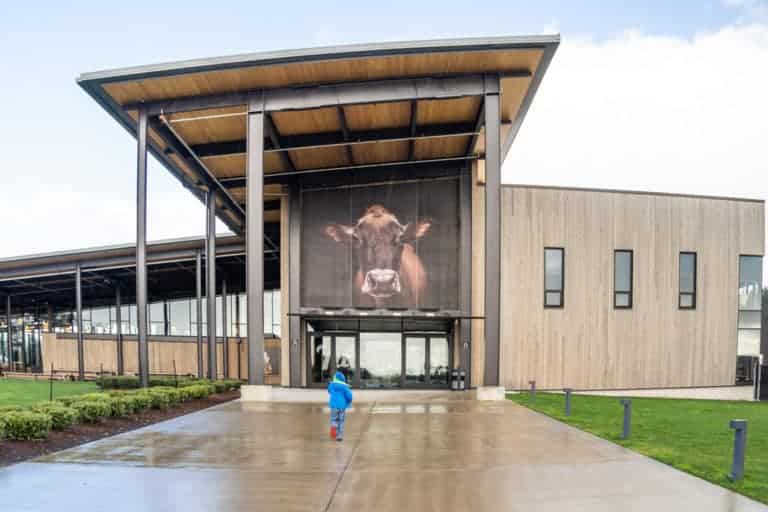Planning an outdoor adventure in the Pacific Northwest can feel overwhelming because there are so many amazing National Parks to explore – it can be hard to choose!
The National Parks in Oregon and Washington are some of the most beautiful and diverse in the USA. From snow-capped mountains to old-growth forests, waterfalls, and rugged coastlines, there is so much to explore within these public lands that it’s hard to know where to start.
So, we’ve put together this guide to the PNW National Parks that you just can’t miss so that you can stop deliberating and start adventuring! Let’s go.
📍We love the audio tours from GuideAlong when visiting new locations!
Quick Note on Operating Hours and Seasonal Closures
Some Northwest U.S. National Parks still have limited operating hours, so double-check before you go. For most of them, you can still access the park, but specific amenities, such as restrooms and Visitor Centers, may be closed.
Here in the PNW, several of our National Parks and recreation sites are at high elevations. Because of this, they can get large amounts of snowfall during the winter. Due to this, some roads and locations will close during the winter months. Road closure and opening dates can vary based on the current season, so it’s always a good idea to confirm your routes and destinations are open before heading off on your adventure.
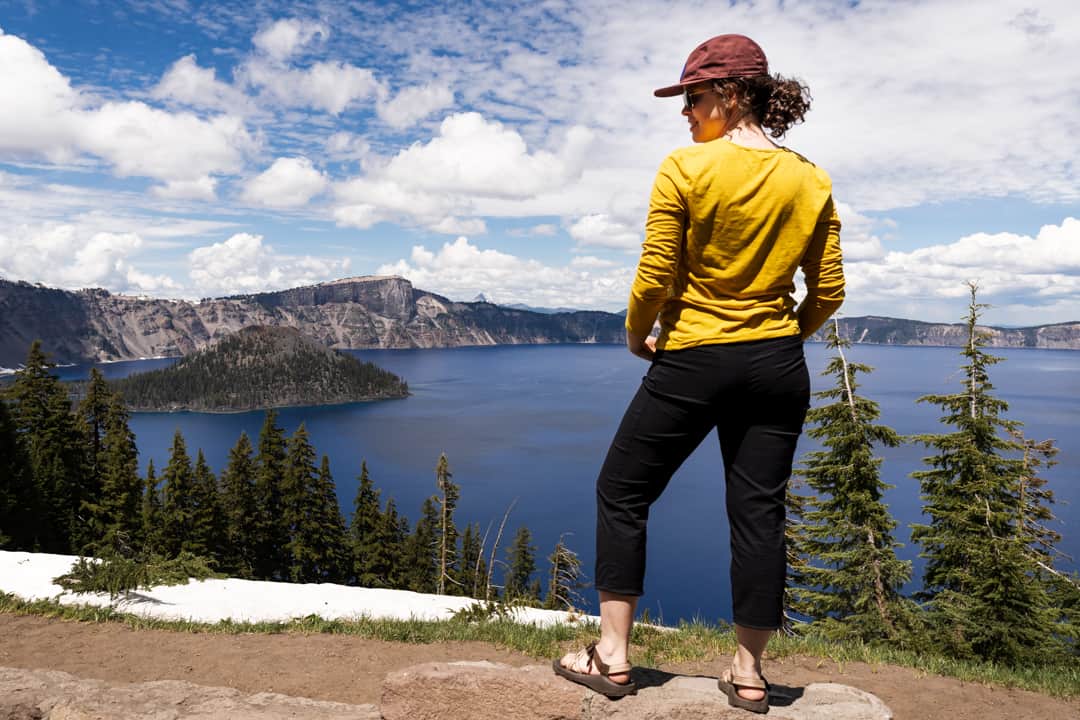
Admission and Fees
You can find information on the admission and day-use fees at the links for each of the National Parks, National Historic Landmarks, and Historical Sites below. However, if you plan to visit multiple sites or for more than a single week during the year, I highly recommend the purchase of an annual America the Beautiful Pass.
If you have a 4th grader, check out the 4th Grade Pass, which gives your child a free pass for their entire 4th-grade year and the next summer!
Oregon National Parks
Oregon is technically only home to one National Park: Crater Lake. But it makes up for its lack of National Parks with plenty of other fantastic adventure spots, like historic sites, epic scenic areas, and national monuments.
Crater Lake
Crater Lake should definitely be at the top of your list of Pacific Northwest National Parks to visit.

When Mount Mazama erupted around 7,700 years ago, it created a giant crater, which is now a gorgeous blue lake. It’s actually the deepest one in the United States at a whopping 1,949 feet deep. The water in the lake is super clear and pure because it’s filled with rain and snowmelt rather than fed by rivers or streams.
Crater Lake National Park is a 4-5 hour drive from Portland, so it’s unsuitable for a day trip from the city. To make the most of this gem, don your best gear and plan a camping trip or stay at Crater Lake Lodge!
The park is home to over 90 miles of trail, but they’re covered in snow for much of the year. June, July, and August are the most popular months to visit. However, running into snow at higher elevations is still possible during these months. It’s always best to check the conditions before going because you never know!
Garfield Peak is one of the most popular hikes in the park, and it’s a 3.4-mile round trip. It is moderate in difficulty, but the views are 100% worth it.
We hiked the trail in July, and it was pretty busy. But it’s less crowded once you move away from the Visitor Center, where most people congregate.
WHERE TO STAY NEAR CRATER LAKE
- Browse these nearby options,
- Try this nearby house that sleeps 6, OR
- If you want to be in the park, book a room at Crater Lake Lodge
More Oregon NPS Sites and Monuments
Mount Hood National Recreation Area

Mount Hood National Recreation Area spans over 34,550 acres and is relatively new. It was established in 2009 and includes three units: The Mount Hood Unit (which surprisingly doesn’t include Mt. Hood itself), the Fifteenmile Unit, and the Shellrock Unit.
Interestingly, while Mount Hood (Wy’east) isn’t actually included in this area, there is speculation that the establishment of the Mount Hood National Recreation Area will eventually lead to its designation as a national park.
But we don’t think you should wait to see this beauty. Whether you visit each of the three designated units or Mount Hood itself, you’ll find plenty to do in this outdoor playground.
If you’re visiting during summer, it’s the perfect location to camp, hike, backpack, mountain bike, or go paddleboarding. During winter, it’s a snowboarding and skiing paradise with multiple resorts and backcountry to explore.
WHERE TO STAY NEAR MOUNT HOOD
Columbia River Gorge National Scenic Area
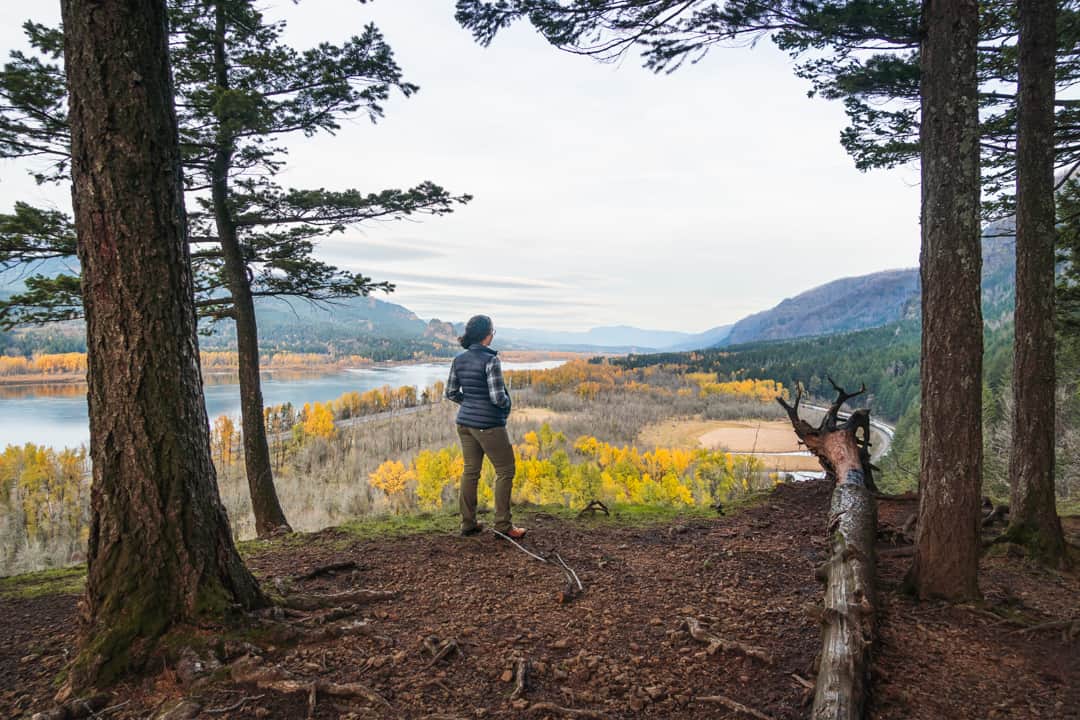
The Columbia River Gorge is a canyon carved by the mighty Columbia River, and it’s absolutely massive. In fact, it’s over 80 miles long and up to 4,000 feet deep in places!
There’s plenty of recreation in the Columbia River Gorge area. It’s definitely one of the best Pacific Northwest National Scenic Areas to visit as a family. Still, it makes a great adults trip, too, with plenty of breweries and wineries to visit nearby. You can even explore the Hood River Fruit Loop, a 35-mile drive that guides you along a route filled with u-pick farms, breweries, cideries, wineries, and more.
Suppose you’re looking for something more active. In that case, the Columbia River Gorge is a super popular area for water sports during the summer. You can go canoeing, kayaking, kiteboarding, and stand-up paddleboarding.
There are also plenty of hiking trails, not to mention pretty waterfalls to explore on the way. This includes Multnomah Falls, the tallest waterfall in Oregon at 620 feet!
WHERE TO STAY NEAR THE COLUMBIA RIVER GORGE
- Browse these nearby options or
- Check out this dog-friendly home with views of the Gorge that sleeps 6
John Day Fossil Bed National Monument

This national monument is located in the state of Oregon and is home to some incredible fossil beds. They date back over 40 million years, which is mind-blowing.
The national monument is spread over three units: Sheep Rock, Painted Hills, and Clarno. Each one is unique and definitely worth exploring!
Visiting the Thomas Condon Paleontology Center is an excellent place to start at John Day Fossil Beds National Monument. This is where you can learn about the fossils found in the area and how they came to be there.
There are also several hiking trails, including the Painted Hills trail, which is probably the most popular because the views of the layered hills are incredible. Over millions of years, different minerals and elements have seeped into the hills, resulting in different colors.
The Trail of Fossils is a short hike along a trail where you’ll glimpse many fallen fossils. This is a must if your kids are into fossils and rocks!
WHERE TO STAY NEAR JOHN DAY
- Lodging near John Day can be a bit of a challenge, but this beautiful home is just minutes away and has stunning mountain views!
Lewis & Clark National Historical Park
This national historic site was created to preserve the home of William Clark – one of the two famous explorers, Lewis and Clark, who explored the Northwest United States.
Lewis & Clark National Historical Park is roughly a 2-hour drive from Portland. Some PNW National Parks require at least an overnight trip, but this one is ideal for visiting on a day trip from the city.
At the historic park, you can see a replica of the expedition’s winter camp and a Visitor Center with exhibits about the Lewis and Clark expedition.
The park is also home to 14.5 miles of trail, including the Netul River Trail, where you can spot eagles and otters.
You can also rent a boat at Netul Landing and enjoy some time on the water or even go fishing.
As with other National Parks, your kids can also participate in the Junior Ranger program, which teaches them all about the National Parks across the USA through various fun exploration activities. At the end, they get a badge and certificate for their hard work!
WHERE TO STAY NEAR LEWIS & CLARK
Nez Perce National Historical Park
Nez Perce is interesting because this National Historical Park is spread across 38 different sites. These sites include the traditional lands of the Nez Perce people and significant areas from the Nez Perce war.
The National Historical Park is spread across four states, but some of its top sites are in Oregon.
You’ll want to visit the Old Chief Joseph Gravesite, one of the most significant locations in Nez Perce National Historical Park. Please remember to protect and respect this sacred site while visiting with the guidelines found here as you learn about Old Chief Joseph, a 19th-century Nez Perce leader who resisted the surrender of ancestral lands.
The Iwetemlaykin Trailhead will take you up to Old Chief Joseph’s burial site, where you can enjoy gorgeous views of Wallowa Lake and Aneroid Mountain on a clear day.
You can also drive up to the Joseph Canyon Viewpoint in Oregon, where you can enjoy the sweeping views of this basalt canyon and learn more about Chief Joseph, the son of Old Chief Joseph.
WHERE TO STAY NEAR NEZ PERCE
- Check out this cute A-frame cabin on the lake in Joseph, Oregon OR
- For larger groups, try this lakefront home for up to 12 with a private boat dock and sauna!
Oregon Caves National Monument & Preserve
This national monument is famous for being the home of the Oregon Caves, a series of marble caves formed by an underground river – and trust us, these caves have really got the wow factor. 🤩
You can find the Oregon Caves in the Siskiyou Mountains, which is a range of mountains that stretch from Northern California all the way into Oregon.
The best thing to do at Oregon Caves National Monument is to tour the caves. To tour the caves, you can choose from four different guided tours (Discovery, Candlelight, Kids and Family, or Off-Trail Cave Tours).
Note: Self-guided tours are not permitted, and reservations are recommended.
WHERE TO STAY NEAR OREGON CAVES
- This updated cabin sleeps up to 8 and has a great firepit and outdoor space.
- Or, for something super unique, what about a treehouse stay?! They even have ziplining, horseback riding, breakfast, and art classes available!
Newberry National Volcanic Monument
This national monument is located within Deschutes National Forest. It comprises four key visitor destinations: Newberry Crater, Lava Butte, Lava River Cave, and Lava Cast Forest.
Here, you can see evidence of past eruptions all around you. It’s fascinating and definitely something that’s a rarity to enjoy.
One of the most popular activities is hiking to the top of Lava Butte. This is an extinct cinder cone, and the views from the top are just incredible. You can see for miles around, and on a clear day, you might even be able to spot Mount Hood!
The Paulina Lakeshore Loop trail is another great option. This is a 7.5-mile trail that takes you around Paulina and East Lakes through forests and lava flows. Despite its length, it’s a very easy loop.
Alternatively, visit Paulina Hot Springs via Little Crater and Paulina Lakeshore Trails, where you can reward yourself for your efforts with a relaxing soak.
WHERE TO STAY NEAR NEWBERRY NATIONAL MONUMENT
- This beautiful home is convenient, has bikes available, and even has electric vehicle charging available.
- Need a bit more room? This fully renovated house sleeps up to 8 in three bedrooms and also provides passes to SHARC, the homeowners’ fitness and aquatic center.
Oregon National Historic Trail (aka Oregon Trail)
The Oregon Trail was arguably the most important route westward in the United States during the 19th century. It stretched over 2,000 miles, and hundreds of thousands of people used it to head west in search of a new life.
The Oregon section of the trail passes through some of the country’s most rugged and beautiful terrain, and there are many historic sites and landmarks to explore along the way.
Birch Creek, located in northeastern Oregon, was a common stopping point for Oregon Trail travelers. The creek is known for its clear water and beautiful scenery. Today, it’s a popular spot for hiking, camping, and picnicking.
Another place to explore is the End of the Trail Interpretive Center, where you can visit the garden that houses two monuments marking the designated end of the Oregon Trail.
WHERE TO STAY NEAR OREGON TRAIL
- Browse these nearby options or
- Try this cozy home nestled in the woods just minutes from the End of the Trail Interpretive Center.
Washington State National Parks
Washington is home to three amazing National Parks worth adding to your outdoor adventure bucket list.
Mount Rainier National Park

Mount Rainier (Tahoma) is located in Washington state and is one of the most famous Pacific Northwest National Parks.
Why? I hear you ask.
Well, because it’s home to the tallest mountain in the Cascade Range, which is, of course, Mt. Rainier itself. The mountain is a massive active volcano that stands at 14,411 feet. 🤯
The National Park was established way back in 1899, and it’s been a mecca for outdoor lovers ever since – us included! It was America’s fifth National Park and it’s home to 260 miles of trail, so bring your hiking boots!
It’s also the closest National Park to Seattle, as it takes about an hour and 45 minutes to drive each way.
There are several Visitor Centers inside the park. Paradise is the most popular, but we have a sweet spot for Sunrise Visitor Center. While it may not be as popular as Paradise, Sunrise is the park’s highest Visitor Center, and it has the most stunning views.
On a clear day, you can see five peaks: Mt. Rainier, Mt. Baker, Glacier Peak, Mt. Adams, and Mt. Hood. It really is a stunning sight to behold.
Sunrise is generally open from late June or early July through late September to early October and closes for the rest of the year. Exact dates vary yearly depending on weather conditions, so check before you go!
Mt. Rainier is one of the most popular PNW National Parks, and it can get busy during the summer months, so it’s best to get off the beaten track if you can. There are many hiking trails, backpacking routes, and more to explore away from the main Visitors Centers.
Mt. Rainer is undoubtedly one of the best National Parks in the Pacific Northwest, and we absolutely love it!
WHERE TO STAY NEAR MT. RAINIER
North Cascades National Park

If we’re talking about National Parks in Oregon and Washington, we must include North Cascades National Park!
This park is often called “America’s Alps” because of its jagged, snow-capped peaks. And really, with these babies in your own backyard, who needs to go to Europe? (Okay, okay. It’s me. 🙋♀️ I need to go to Europe. 😆)
Anyway, back to North Cascades. The park is enormous – it covers over 500,000 acres of land and is home to 300 glaciers. Plus, it boasts some of the most varied flora and fauna of the Northwest U.S. National Parks and of National Parks across the whole country.
This park is also one of the closest National Parks to Seattle. It’s around a 2-hour drive each day, so you can even visit on a day trip from the city.
As for things to do in North Cascades National Park… Where do we even begin? There are SO many adventures to be had here. You can go camping, backpacking, horseback riding, and rock climbing.
There are also some great scenic drives that you can take to make the most of the incredible views. The Cascade River Road is a particular favorite – it’s a winding road that follows the Cascade River for 23 miles. Check the road conditions before heading out, as it can close for rockslides and seasonal closures.
And, of course, North Cascades National Park is home to some of the best trails in the Pacific Northwest. There are over 400 miles of trail here, which range from easy to strenuous.
If you’re in the mood to take it easy, the Happy Creek Forest Walk will take you through an old-growth forest towards a pretty waterfall. This accessible trail is a loop that is primarily on a boardwalk, making it the ideal loop for those with strollers or wheelchairs.
For something a little more challenging, Thunder Knob Trail will reward you with stunning views of Diablo Lake.
And if you’re an experienced hiker, the Sourdough Mountain Hike can be a bit grueling, but boy-oh-boy, are the views of the Cascades worth it!
WHERE TO STAY NEAR NORTH CASCADES
- Stay at the gateway to North Cascades in this forest cabin with hot tub and firepit just 12 miles from the park!
- Or try one of the cabins at Glacier Peak Resort and Winery.
Olympic National Park

You know that “take my breath away” song they play about 100 times in the movie “Top Gun”? That’s how Olympic National Park will make you feel.
It’s the biggest of the Northwest U.S. National Parks. In fact, it covers almost a million acres – roughly twice the size of the North Cascades National Park, which is already pretty darn huge!
Olympic National Park is home to three ecosystems: the temperate rainforest, the Pacific coastline, and the alpine mountains. You can find anything you want in this park.
📍Download the Olympic National Park audio tour from GuideAlong for your visit!
It is one of the best National Parks in Washington State and worthy of a place on your bucket list.
You could spend years exploring Olympic’s old-growth forests, scenic rivers and waterfalls, and the beautiful Pacific coast. But if you don’t have years, there are a couple of must-dos.
If you’re up for some adventure, hiking the Obstruction Point Trail is one of them, with its incredible views of the National Park and glorious diversity. This trail is just under 14 miles out and back and has a little over 3200 feet of elevation gain. The sheer beauty of mountains, glaciers, and meadows will send chills down your spine.
Another top activity is visiting Hurricane Ridge, which is one of the most popular spots in the park and offers some of the best views. It’s also one of the only places you can ski or snowboard in a U.S. National Park.
The Hoh Rainforest is also unmissable because it’s the largest temperate rainforest in North America and is famous for being one of the quietest places on Earth! There are many hiking trails through this ancient forest, along which you’ll see lots of unique plant life.
WHERE TO STAY NEAR OLYMPIC NATIONAL PARK
Wondering where to stay during your trip?
- Stay at Misty Valley Inn a lovely Bed & Breakfast in Forks
- Prefer a lakefront retreat within the park itself? Check out this 3-bedroom home on 7 acres that sits on Lake Quinault.
More Washington NPS Sites and Monuments
Fort Vancouver National Historic Site
Fort Vancouver National Historic Site is located just north of Portland, Oregon, in Washington. This was the headquarters of the Hudson’s Bay Company, a fur trading business that had a monopoly on the fur trade in North America.
The site has played home to several different cultures, including British and Canadian settlers and Indigenous peoples from all over North America.
You can visit a replica of the Hudson’s Bay Company fort, see two reconstructed worker houses in the village, or view the extensive collection of artifacts at the site’s museum.
The park has several relatively short and easy trails ranging from 0.2 miles to 3.0 miles long.
WHERE TO STAY NEAR FORT VANCOUVER
To visit Fort Vancouver, you have plenty of lodging options in Vancouver or a short drive away in Portland.
- Prefer a vacation house? Try this adorable Tiny House in the Kerns neighborhood or this Midcentury Modern home convenient to Restaurant Row.
San Juan Island National Historical Park
San Juan Island National Historical Park is a beautiful National Historical Park celebrated for its scenery and wildlife. The island is home to many species of animals, including the famous orcas or killer whales.
You can learn more about the history of this National Park and how Great Brittain and the United States almost went to war over ownership of the island – and how the dispute came to a head over the death of a pig!
There are also 20 miles of trail in the park. The Old Military Road Trail (also known as the American Camp Trail) is a popular choice. It takes you between the American and British military camps. The Frazier Homestead section of the trail even takes you to where the infamous pig was killed.
WHERE TO STAY ON SAN JUAN ISLAND
Wondering where to stay during your trip?
- Browse these nearby options or
- Try this home with a water view and hot tub minutes from the Historical Park.
Whitman Mission National Historic Site
The Whitman Mission National Historic Site was created to observe the deaths of Marcus and Narcissa Whitman, as well as the role the Whitmans played in westward expansion.
The Whitmans were Methodist missionaries who arrived in the Oregon Country in 1836. They established a mission near present-day Walla Walla, Washington.
Ultimately, in 1847, Marcus and Narcissa Whitman were killed, along with 11 other people, when the Cayuse attacked the Whitman Mission. While the results of the attack are tragic, many questions still remain regarding the circumstances of the event and whether it was revenge, retribution, or perhaps a combination of both.
There’s a great self-guided audio tour you can take to learn more about the history of the Whitman Mission. You can also look at some of the artifacts on display in the Visitor Center, enjoy a picnic in the shelter, or explore the grounds via the short Mission Grounds Loop.
WHERE TO STAY NEAR WHITMAN MISSION
- Browse these nearby options or
- Try this beautifully appointed loft minutes away from Whitman Mission. We have personally stayed here and loved it! I do want to point out you have to climb stairs to access the loft and there is no elevator.
- Or, you can try this super unique property where you can sleep in a wine barrel or a barn!
Lake Roosevelt National Recreation Area
Lake Roosevelt National Recreation Area is a national recreation area rich in history and natural beauty.
The lake itself is roughly 150 miles long. The body of water is popular for boating, canoeing, kayaking, and fishing. At the same time, the surrounding area is perfect for hiking, camping, and bird-watching.
The Kettle Falls area is especially popular among visitors. The Kettle Falls Trail stretches from the Kettle Falls Marina to the Colville River and covers 5 miles in total.
It’s easy, but you don’t have to do the entire stretch. The trail is broken into North, Middle, and South sections, and you can tackle just one of them if you prefer.
WHERE TO STAY NEAR LAKE ROOSEVELT
- Check out this private cabin with optional RV site
- Or stay in this waterfront home with 16 beds in four bedrooms – plenty of room for a large group!
Mount St. Helens National Volcanic Monument
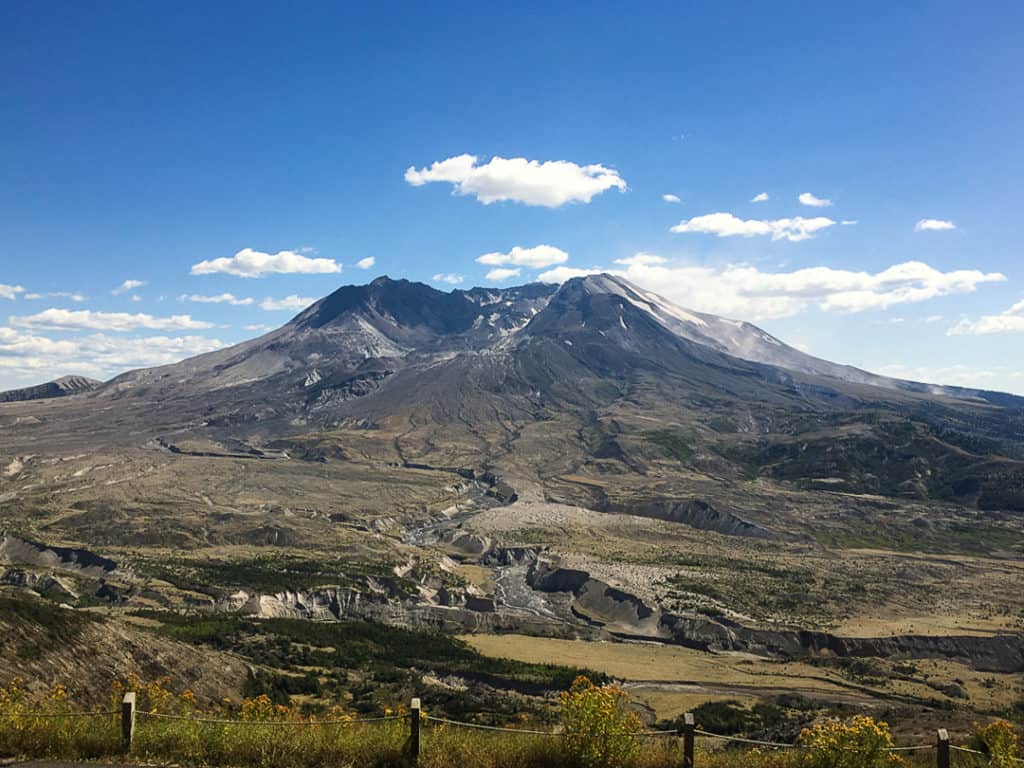
Mount St. Helens is an active volcano that famously erupted on May 18, 1980, killing 57 people, making it the most destructive in U.S. history.
On the day of the eruption, a massive column of ash shot up into the sky that was visible 120 miles away in Seattle, while an avalanche and lateral explosion caused severe destruction to nearly 150 square miles of the park.
Before the eruption, everyone who lived within 15 miles of the area had been advised to evacuate. Some did, but others refused because they feared losing their homes and livelihoods.
Visiting the Johnston Ridge Observatory is our #1 recommendation for things to do at Mount St Helens. It gives you an excellent view of the volcano; if you’re lucky, you might even see steam rising from its cone! 🤯
The observatory is also a fantastic place to learn about volcanoes and their effects on the landscape. There are many interesting exhibits, including a film they screen several times daily for visitors to teach them about the eruption and how the park landscape has transformed since the blast.
When you’re ready for a hike, there are lots of great trails in the park, some of which can take you right up to the crater’s edge.
WHERE TO STAY NEAR MOUNT ST. HELENS
- Check out this adorable Sky Cabin that sleeps 4 OR
- Stay on the lake in this 2 bedroom home and enjoy a large outdoor area that includes a grill, chiminea, picnic table, hammocks, and more!
Map of National Parks, Sites, and Monuments in Oregon and Washington
When organizing your visit to the National Parks in Washington and Oregon, it can be helpful to see them all on a map in order to plan your route. Feel free to use the map below of Pacific Northwest NPS sites and monuments to aid in your planning!
FAQs About National Parks in the Pacific Northwest
How many National Parks are in Washington?
Washington State has 3 stunning National Parks – Mt. Rainier National Park, Olympic National Park, and North Cascades National Park. However, it has many additional NPS Sites and Monuments to explore, such as Mount Saint Helens National Volcanic Monument.
How many National Parks does Oregon have?
Crater Lake is Oregon’s singular official National Park. However, you’ll find lots of NPS Monument and Historic Sites, such as Columbia River Gorge National Scenic Area, throughout the state.
What is the least visited National Park in Washington State?
The least visited National Park in Washington State is North Cascades National Park. It sees only around 30,000 visitors a year while both Olympic and Mount Rainier National Parks boast around 2 million per year.
Final Thoughts on National Parks in Oregon and Washington
Oregon and Washington are home to some of the best National Parks in the United States. And, if you love outdoor recreation as much as we do, the diverse landscapes of the Pacific Northwest won’t disappoint.
If you’re looking for an adventure, there’s no better corner of the country to explore than the Pacific Northwest. Its epic scenery will never fail to excite, delight, and inspire you.
Happy adventuring!
Related Articles About National Parks
- Where to Stay in Yellowstone National Park
- Yellowstone 3 Day Itinerary: What You Need to See
- Grand Teton National Park in One Day
- How to Spend One Day in Yosemite National Park

